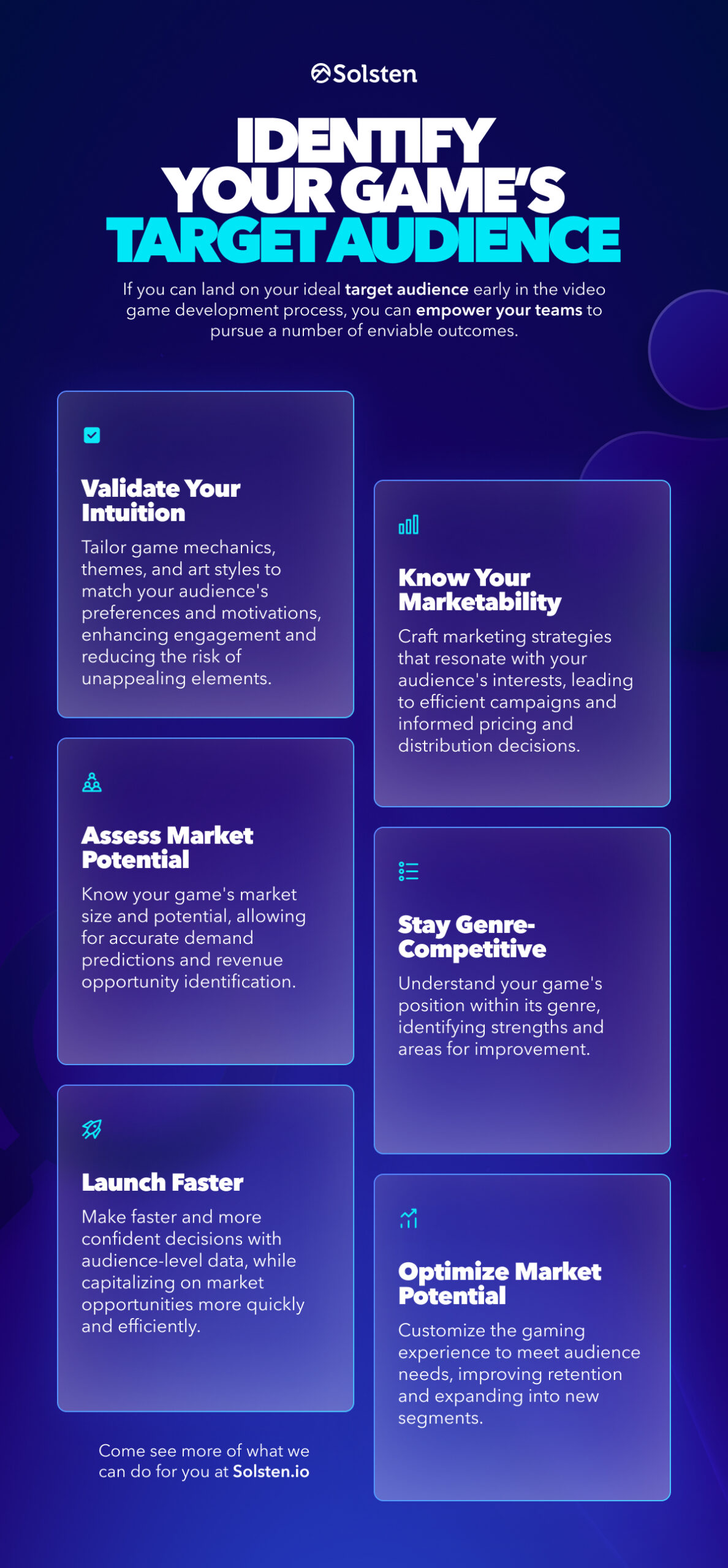Identifying the ideal target audience for your game comes with a world of benefits for studios and publishers — all with the end result of saving time and resources. If you can pinpoint your game’s ideal target audience early in the development process, your team can achieve a number of enviable outcomes. These include:
- Validate Your Intuition: Tailor game mechanics, themes, and art styles to match your audience’s preferences and motivations, enhancing engagement and reducing the risk of unappealing elements.
- Know Your Marketability: Craft marketing strategies that resonate with your audience’s interests, leading to efficient campaigns and informed pricing and distribution decisions.
- Assess Market Potential: Know your game’s market size and potential, allowing for accurate demand predictions and revenue opportunity identification.
- Stay Genre-Competitive: Understand your game’s position within its genre, identifying strengths and areas for improvement.
- Launch Faster: Make faster and more confident decisions with audience-level data, while capitalizing on market opportunities more quickly and efficiently.
- Optimize Market Potential: Customize the gaming experience to meet audience needs, improving retention and expanding into new segments.
> Read our article on Market Potential Analysis here.
These outcomes and many more are possible because an ideal target audience informs all elements of game development and marketing from every angle. But what is an ideal target audience? How does identifying it help achieve these things? And how do you identify it in the concepting stage of a video game?
In this article we’ll answer these questions, and show how identifying your ideal target audience can be a core driver of your game’s success.
Why Focus on Your Target Audience?
Finding the ideal target audience is crucial for new games. It positively influences every aspect of game design and development by ensuring alignment with player motivations.
It informs effective marketing and promotional strategies, and vastly increasing the chances of commercial success. It also allows for optimal resource allocation, reducing the risk of wasted efforts and financial losses.
Additionally, understanding the ideal target audience is essential for building a robust gaming community, which enhances player engagement and loyalty. It lets you plan from a forward-looking, strategic vantage point, letting studios get ahead of market trends and reach new players. In short, knowing your audience is not only vital for immediate success but also for maintaining growth and relevance in the gaming industry.
What is an Ideal Target Audience?
A video game’s ideal target audience is a specific group of players characterized by unique psychological traits that align closely with the game’s design, themes, and overall experience. These players are the ones that are most likely to engage with, enjoy, and spend money within the game.
How does that work in practice? Imagine two circles. One contains the audience you are building your game for. The other contains the audience that is most likely to want to enjoy and play your game. At the intersection of these two circles is your ideal target audience. In a perfect world, these circles overlap so much that they become one large circle. But video game developers often think they’re making their game for one audience, only to realize it has far more appeal to an audience they weren’t really aware of. This is largely due to a misunderstanding of what a target audience is.
Curious about the psychological traits driving your game’s ideal audience? Elaris can help you discover the motivations, values, and personalities behind any gaming audience in seconds. Learn more
A Demographic is Not an Audience
A game’s broad demographics, often simplified as “age group, gender, and genre” offer a limited set of parameters when it comes to defining your target audience. In today’s saturated market, it isn’t not enough. For example, it’s common for an entire genre, like Match 3, to have seemingly similar demographics. However, when you go below the surface, there’s a much richer picture than that.
Yes, Match 3 players average 40 years old and 70% female. But there’s so much more to know about Match 3 players than that: within this broad demographic, there are seven specific groups of people. Each of these groups have distinct motivations, personalities, and characteristics. The group with the highest lifetime value (LTV) is actually 38% male.
Thought leaders such as Mitchell Smallman from Pocket Burger Games are also emphasizing the crucial difference between “demographic” and “audience.”
“I say you should think about your audience first. People say, ‘Ah cool, I’ve done that! I know our demographic!” says Smallman in a recent discussion with Elitegame Developers’ Achrén. But, Smallman says, those people are not only confusing the terms — they’re also unnecessarily limiting their design vision.
“[Previously], you’d describe your game audience as genre, age, gender, and platform. And that’s how marketing works — and it’s a helpful way to work sometimes. But none of these categories are monoliths with universal behavior within them. So every time you say, ‘Hey, I’m going to add 18-24 year old women, you’re actually muddying the waters. You think you’re doing something specific, but you’re actually doing something quite broad and general. And if you treat it like something specific, you won’t do the best design.”
From months of research to minutes of conversation
Traditional audience research takes months and costs thousands. Elaris gives you psychological insights about any gaming audience instantly. Start free, and upgrade to premium features for a fraction of traditional research costs.
How to Find Your Ideal Target Audience
To find your target audience, you need to get to the core of who that audience is.
Given that demographics alone don’t provide game designers and developers with a comprehensive understanding of their target audience, it’s important to redefine our understanding of an audience. This broadened perspective can lead to increased potential for creating exceptional and successful games.
The first task: identify the emotional core of what your audience desires. To do this, understand who they are at their core. Do they seek relaxation? Socialization? Competition? Who are their companions? What are their values, habits, and passions? How would you describe their personalities? What other games are resonating with them, and why?

What’s an example of a target audience?
According to Smallman, “You could say, ‘We’re making a game for 22 to 24-year-old men who like strategy games.’ But that’s not nearly such a detailed picture of your audience as saying, ‘We’re gonna make this game for people who like Clash of Clans, people who have played Starcraft, but don’t have time anymore, but do have time to play on their phones, and don’t have the large amounts of disposable income to go and spend 60 bucks on a new Starcraft game on their phone.’”
He argues that the most effective audience-first approach involves anticipating the genuine emotional promise that will resonate with your audience. This includes understanding their preferences for certain types of games and art styles, the devices they use for gaming, and more.
Indeed, Smallman is a significant step ahead of those relying solely on demographics, yet he still falls short of fully understanding his audience. To genuinely understand your audience, it’s vital to empathize with them. Until now, even the most advanced audience-first approaches were based on assumptions. This was due to the lack of technology to transform audience definition from educated guesswork into analytical certainty.
The New Way to Identify Your Game’s Target Audience
“True audience-first design starts with empathy. To gain empathy, we need to be able to put ourselves in our target audience’s shoes. To put yourself in their shoes, you need an intimate understanding of what your target audience wants — what they value, what their personality is like, what bothers them, what lights them up, what resonates with them, and so on,” says Joe Schaeppi, CEO and co-founder of Solsten.
“We wanted that holy grail: the ability to dial the intended audience in so far that game design could almost naturally unfold from this initial understanding. So we built a true empathy engine and made it accessible to every developer through Elaris.”
Elaris is an AI-powered audience intelligence tool that lets you have natural conversations with the world’s largest psychological gaming database. It lets game developers find their ideal target audience while they are still in the concepting stage. The number one reason games fail is that they fail to find their audience. Elaris finds that audience, and provides detailed psychological data that lets developers make a game that will engage it over the long term.
Elaris starts at the deepest level of player psychology and user privacy. It develops AI-enabled, psychologically-based insights derived from the largest psychological database in the world. Since you don’t need a live game to use Elaris, developers can truly put their game’s target audience first. They can design, develop, and bring new games to market with a clear view of their ideal target audience in sight.
Detailed insights into your target audience let you do more than just develop successful games. They make the entire process more efficient, more accurate, and infinitely more cost-effective. Designers are empowered to do their absolute best work. Marketing efforts can be deployed with precision. Ad campaigns can reach and target the audience more efficiently. The entire studio is empowered to thrive.
Experience the power of psychological audience insights instantly
Elaris brings psychological insights to any developer or marketer. Simply ask: “Show me the personality traits of puzzle game players” or “What motivates my competitor’s audience?” Get the empathy-driven understanding you need to create games that truly resonate.



